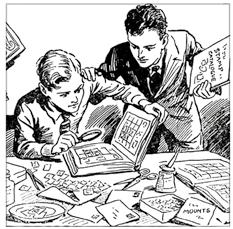
4 minute read
Stamp of approval
Paul V. Tattersall relates how stamp collecting saved the sanity of many older people during the Covid lockdowns and how many of them have returned to their childhood hobby.
Most older people can remember when stamp collecting was the number one hobby for boys, and indeed many girls, in their younger days, particularly those growing up in the Fifties, Sixties or Seventies. As times moved on so did pastimes and video games or other newer pursuits took over and young people put away their stamp albums in the attic or gave them away to younger siblings.


However, over the last couple of years, when the Covid pandemic was raging and people were told to stay home, many older people, unable to visit family or friends, felt very isolated in their homes. One can get very tired of mindless daytime TV, and quite a few people, tidying the house or rummaging in the attic came upon their old stamp albums and a long-lost interest was re-kindled. This particularly happened to those who, while abandoning the hobby as college, work, dating, etc., took over, still couldn’t throw away a nice stamp; so, they tore it off the envelope and put it in a shoebox on top of the wardrobe. During the lockdowns some people got down these shoeboxes and set about sorting out the contents, only to be bitten by the bug once again.
Stamp collecting, or philately to give it its proper name, can be a very fulfilling hobby, with many beneficial side effects. Obviously it is a relaxing hobby, but also can be a very sociable one. For example, the Dublin Stamp Society, which has been active since the 1940’s, caters for members who wish to get together once or twice a month to discuss their various collecting habits, put on displays of their collections, ask questions or buy and sell items at the little auctions or ‘Bourses’, conducted at the meetings. Apart altogether from making a new bunch of friends.

Re-organising a collection, exchanging with other collectors both in Ireland or abroad, and sorting out stamps to send to such exchange partners is a good exercise to keep one’s mind active and stave off the onset of dementia. countries only, like Ireland or Europe, others collect stamps with special frank marks, while others collect thematically concentrating only on stamps featuring ships, or birds, or music, or Christmas,
Three vintage Irish stamps from the 1920s worth around €400
Issued in the United Kingdom in May 1840, the Penny Black was the first adhesive stamp in the world, which is why this stamp is considered so valuable. The Penny Black carries a picture of Queen Victoria and does not show the country of origin, as is custom today. Despite there being plenty of Penny Blacks for sale, an unused one can earn a lucky owner around €3,000, making it a very popular amongst collectors.
etc., which can make for some very attractive displays. Other collectors specialise in ‘dead’ countries, eg., countries which have ceased to exist, like East Germany, Ceylon, Tanganyika or Rhodesia, while some others collect British stamps which feature Irish postmarks, eg., stamps in use before 1922.
Then, of course, there is also the interesting possibility of coming across a stamp with a flaw, or printing error, which might be worth thousands! Before Independence some Irish Republicans used to put stamps featuring Queen
Victoria’s head on their envelopes upside down, and some of these envelopes have become collectors items now! During the lockdowns collectors who exchanged with others abroad benefited from a constant source of entertainment when letters arrived on their doormats from exchange partners in far flung places with stamp packets containing a hundred or more foreign stamps. It could easily take half a day to sort these out chronologically, thematically, or by country, put them into the appropriatealbum and then select a suitable collection of stamps to send back in return. The walk to the nearest postbox also provided useful fresh air and healthy exercise!
Stamp collecting has received a muchneeded shot in the arm over recent years with all the ‘new’ countries which came out of the break-up of the USSR and Yugoslavia. Many of them have issued very attractive stamps featuring events in their history which they could not commemorate before. Also, the recently growing middle class in China have taken up the hobby with a vengeance, according to Stanley Gibbons, the major UK stamp company, which reports that the official Stamp Club of China now boasts over 20 million members.
So, if you are looking for an interesting new pastime, want to meet a new circle of friends, and keep the little grey brain cells active, why not consider philately – it’s informative, educational, sociable, more entertaining than watching daytime TV and less strenuous than golf! The Dublin Stamp Society welcomes aspiring new members, has a modest €25 annual membership fee and meets just off convenient St. Stephens Green for those who are interested.


The year 1847 was significant for US stamp collectors as it was the first year in which the public could purchase stamps from the Government. When the U.S. got its first president, his portrait became the go-to picture for several posts, paintings, and stamps. In 2008, one of these stamps was sold for $900,000. While there were around 1,000 stamps of this kind, only four are known to exist today.
For further information:
Dublin Stamp Society. Box 12624 Rathfarnham, Dublin 16
Paul V. Tattersall, President. Email:
tattersallpv@gmail.com











